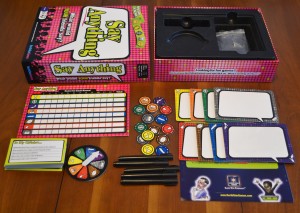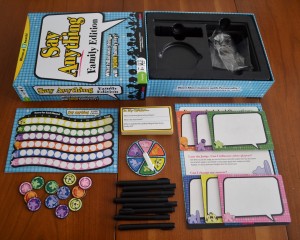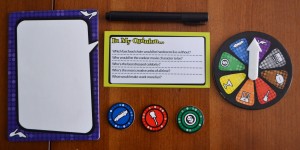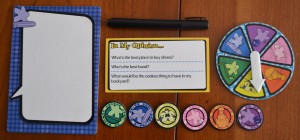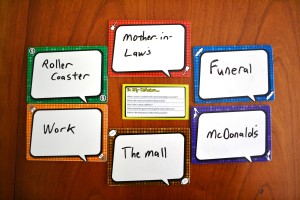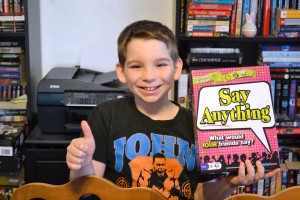“Say Anything” and “Say Anything Family” were among the first board games to enter my “new” collection, my old one having been lost in a series of floods several years earlier (que sad Panda face). Both games revolve around the same theme, much like “Wits & Wagers” and “Wits & Wagers Family” do. They aren’t that different from one another, so I’ll be covering both here to save on time. “Say Anything” and “Say Anything Family” can be described as light party games, designed for either adults (the former) or family game night (the latter). Let’s take a quick look at what comes in each game and how they are played before heading into the review.
Editor’s Note: I published a review for this game years ago, but felt it could be better. As such, this article will serve to modernize my older (AKA crappier) review and bring it up to date with my current review format. The old review has been retired.
Components
Scoreboard (Both Versions) – On this markerboard, player colors are shown vertically along the left side while the round numbers are depicted horizontally along the top. The scorekeeper will start from the left and work their way to the right as rounds are completed.
Trivia Cards (Both Versions) – Trivia cards contain questions that pose hypothetical situations. The reader of the trivia card will say “In my opinion…” and then read off the question / situation. More on how that all works in a bit.
Answer Boards & Markers (Both Versions) – Each player will receive an answer board of their color and a marker. These are used to write down answers to questions posed by the trivia cards. There are eight boards in the regular version and six boards in the family version.
Answer Wheel (Both Versions) – The answer wheel contains a pie piece of every player color. Using the attached arrow, the current player will use this to lock in their favorite answer before betting occurs. This is mainly used so as to prevent cheating.
Bidding Tokens (Both Versions) – There are two tokens of each player color, which are used to bid on answer boards in order to score points.
Eraser (Not Included In Either Version) – I recommend having a few erasers handy, as you’ll be erasing answers after every round.
Setup & Gameplay
Each player receives a markerboard and the two betting tokens of the same color, along with a marker. One player is designated as the scorekeeper and keeps the scoreboard nearby. The trivia card deck is placed within easy reach of all players.
On a player’s turn, they’ll take a trivia card from the deck and read off one of the questions, making sure to say “In my opinion…” before reading it. For example, the current player might ask, “In my opinion…what is the worst thing you could do in public?”
At this point, every other player writes down an answer on their markerboard and places it into the center of the table. It’s really important for players to answer the question based off of what they think the reader of the card would do in that situation. YOU might think that the worst thing you can do in public is let one loose after eating a six bean burrito, but the reader of the card might be a bit more “care-free” than you.
Once everyone but the card holder has submitted an answer, the card holder will secretly pick their favorite answer on the answer wheel by choosing the appropriate color. The wheel is placed face down after that to prevent the card holder from changing their answer.
After that, everyone but the card holder bids on the answers, trying to guess what the card holder picked as their favorite. Players do this by placing their two bid tokens on top of the available answer boards.
Finally, scoring for that round occurs and the answer wheel is revealed. The card holder receives a point for every bid token on that answer board, up to a maximum of three points. The other players receive one point for every bid token they have on the answer that was picked. The person who wrote the best answer also gets a bonus point. The most anyone can score in a round is three points. The scorekeeper notes the points awarded and play proceeds clockwise. The person with the most points after so many rounds wins the game! (The number of rounds depends on how many people are playing)
The above is simply an overview of the game, but should give you an idea of how it is played. For more information, please visit the links at the end of the article. There’s also a manual, located here:
http://boardgamegeek.com/file/download/34j8jkkuyc/Say_Anything_Rules.pdf
The Review
I’ll keep this short and sweet…out of all of the games in my household, this one is the game most requested. The kids really enjoy coming up with silly answers, especially when it comes time to point out my opinion in various situations. Every answer I received on my turn revolved around “Star Trek” in some way…perhaps they are trying to tell me something? We even brought this game out during a family & friend get-together, where most of them are not gamers by any sense of the definition. Rather than score points, we just passed around the trivia deck and answered questions in humorous and inappropriate ways…this was, of course, after we sent the kids upstairs. Pictures were drawn and secrets were revealed, though it was all in good fun.
There isn’t that much difference between the two games, in all honesty. The cards in “Say Anything” are a bit more open-ended to where adults can take advantage of “dirty-minded” answers, though playing it with family and keeping things PG is easily doable. Likewise, the cards in “Say Anything Family” are bit more cutesy in nature, but can be used in an adult setting. Both games are flexible that way, which I appreciate. The regular edition is designed to accommodate eight players, making it a tad more appealing than the family edition, which only accommodates six.
Is either game right for you? Well, that depends. “Say Anything” and “Say Anything Family” is a very social experience, one that gets better the more people you have playing. If it’s just you and a spouse, it may not be all that rewarding unless imaginary friends are involved somehow (hey, I’m not judging). If you host or attend parties on a regular basis or have regular family game nights that involve more than three people, then either game will fit the bill nicely. It’s a great way for people to learn about each other and well worth the investment.
Final Verdict: 9/10
—
You can learn more about the game by visiting the official site, here:
http://northstargames.com/North_Star_Games/Say_Anything.html
—

